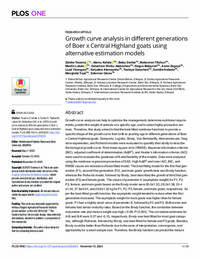Growth curve analysis in different generations of Boer x Central Highland goats using alternative estimation models

Authors:
Growth curve analysis can help to optimize the management, determine nutritional requirements,
predict the weight of animals at a specific age, and to select highly productive animals.
Therefore, this study aimed to find the best-fitted nonlinear functions to provide a
specific shape of the growth curve from birth to yearling age in different generations of Boer
x Central Highland goats. Gompertz, Logistic, Brody, Von Bertalanffy, Monomolecular, Negative
exponential, and Richards models were evaluated to quantify their ability to describe
the biological growth curve. Root mean square error (RMSE), Bayesian information criterion
(BIC), adjusted coefficient of determination (AdjR2), and Akaike’s information criterion (AIC)
were used to evaluate the goodness of fit and flexibility of the models. Data were analyzed
using the nonlinear regression procedure of SAS. High AdjR2 and lower AIC, BIC, and
RMSE values are indicators of best-fitted model. The best-fitting model for the first filial generation
(F1), second filial generation (F2), and male goats’ growth data was Brody function,
whereas the Richards model, followed by Brody, best described the growth of third filial generation
(F3) and female goats. The values of parameter A (asymptotic weight) for F1, F2,
F3, female, and male goats based on the Brody model were 30.5±1.32, 28.2±1.38, 24.4
±1.04, 27.8±0.94, and 29.8±1.32 kg for F1, F2, F3, female, and male goats, respectively. As
per the best-fitted growth function, the asymptotic weight tended to reduce when the filial
generation increased. The asymptotic weight for male goats was higher than for female
goats. F1 had a slightly small value of parameter K, followed by F2 and F3. Both males and
females had similar maturity rates. Based on the Brody function, the correlation between
maturation rate and mature weight was high (-0.98, P<0.001). The correlation estimates for
A-B and B-K were 0.27 and -0.15, respectively. Brody was best fitted for most goat categories,
although Richards, followed by Brody, was best fitted for female and F3 goats. Besides,
Brody could be better than Richards due to the ease of interpretation, convergence, and
applicability for a small sample size. Therefore, the Brody function can predict the mature body weight, maturation rate, and growth rate of Boer x Central Highland goats and be used
to formulate breeding and management strategies for profitable goat farming.
